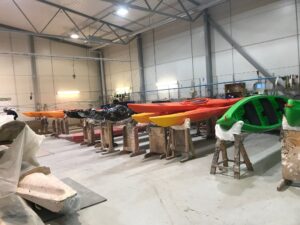Speed up the transition with Circular Design
Why is Circular Design so important? What is the EcoDesign Sprint 4.0?
On 29th of March 2021, Design Forum Finland, Estonian Design Centre and the Swedish Industrial Design Foundation (SVID) organized the webinar “Speed up transition with circular design” to cover the question: Why is circular design so important? In this article we take a closer look at what can be learnt from the EcoDesign Sprint 4.0 as applied in an Estonian enterprise Tahe Kayak.

Tahe Kayak | ©Kaire Rannik, Estonian Design Centre
Design methods and design mindset can considerably contribute to creating a better functioning world and society. Complex problems can be grasped and solved. To understand customers and their needs, companies can use different design methods. Circular design is also a tool to develop products and services in a comprehensive way. Companies can use the strategic use of design to create sustainable growth and competitiveness by being better prepared for the challenges of both today and tomorrow.
The EcoDesign Sprint is a collaborative training programme for small and medium sized companies interested in transforming their businesses towards a circular economy. In addition, design agencies get to deepen their knowledge in circular economy concepts.
The Sprint is designed to improve operating models – linking design and principles of the circular economy and ensuring business competitiveness. The transformation to a circular economy is important across all sectors – once you have learned what impact it has on businesses, you can start to develop circular (growth) strategies. Unlike the traditional EcoDesign Sprint, the EcoDesign Sprint 4.0 is not only designed for products, but also for services.
Tahe Kayak – a manufacturer of canoes and kayaks
One of the three EcoDesign Sprint 4.0 pilots was carried out with the Estonian company Tahe Kayak. Tahe Kayak is a manufacturer of canoes and kayaks whose customers are mainly based in Scandinavia and Northern America. The company belongs to the Tahe Outdoors group. In the sprint, they decided to concentrate on the premium brand “Zegul”.
There are two different methods of manufacturing kayaks: rotation manufacturing and customer-built kayaks. The customer-built kayaks are mostly made of many different materials, including carbon fibre and other material blends – these make the kayaks stable and guarantee a long product life, but they are also harder to recycle. The goal of the sprint was to develop a strategy for reselling used kayaks and giving them a second life.
The two-day sprint was very intensive for the participants, but it was also a huge success. The Sprint was conducted by an Estonian environmental expert (Kaisa Hansen, innovation and business centre Mektory) and an Estonian service designer: Joel Kotsjuba (Velvet design agency).
Joel Kotsjuba summarised the ten most important key takeaways from his side:
- The EcoDesign Sprint provides a good baseline understanding of circular design theory, concept, strategies and methods for implementation.
- From the perspective of a successful transition into circularity, the EcoDesign Sprint holds a specific role in building momentum and finding key opportunities for focus in each company. While this does provide the most value, it won’t solve all the challenges.
- Engament of decision-makers during the Sprint preparations and in planning the follow-up activities are important for the succes of the Sprint outcome and further concept implementation. The follow-up work should be very well planned in order to get the maximum business value of it. The decision-makers’ involvement is important because certain decisions made during the Sprint will determine the potential of ideas both for the company and for circularity in general.
- The two days of the EcoDesign Sprint provide a good basis to discover opportunities for circular design implementation, but extra work is needed to develop an idea into a concept.
- The EcoDesign Sprint provides numerous ideas for improving and reinventing production, products, services and employee satisfaction. The combination of product and service development with circulat design knowledge is very valuable for the company.
- The evaluation and selection of initial ideas for testing are important to gauge their potential. The key to engagement and commitment from the decision-makers is the way these ideas are evaluated and selected.
- Establishing trust and good energy between facilitators and the participants of the Sprint is important. This is the basis from which good ideas start to flow and companies are willing to share their strenghts and challenges. This is also when the facilitators can provide the biggest impact for the company. Without trust it is very difficult to achieve anything meaningful.
- Engaging real customers to validate ideas provides huge benefits as it is real user validation and offers an external point of view. Circular solutions have to be attractive to the users, after all.
- Service design holds an important role in the circular design transition and should be considered in Sprints, because: a) the service-based approach is one of the key strategies into circularity; b) successful circular solutions should be user-tested and gain user attraction. Engaging service designers will contribute to that.
- Engaging designers to the Sprint helps to develop more mature circular ideas & concepts. The better prepared everybody is for the Sprint, the more you will get out of it. Different companies may need different expertise from design. Different designers – whether industrial or service designers – can have a very good impact in terms of how far the ideas will be developed within the Sprint.
Use tools to develop incremental steps towards your circular future (The Circular Design Toolkit)
Article source: https://disainikeskus.ee/designblog/speed-up-the-transition-with-circular-design



